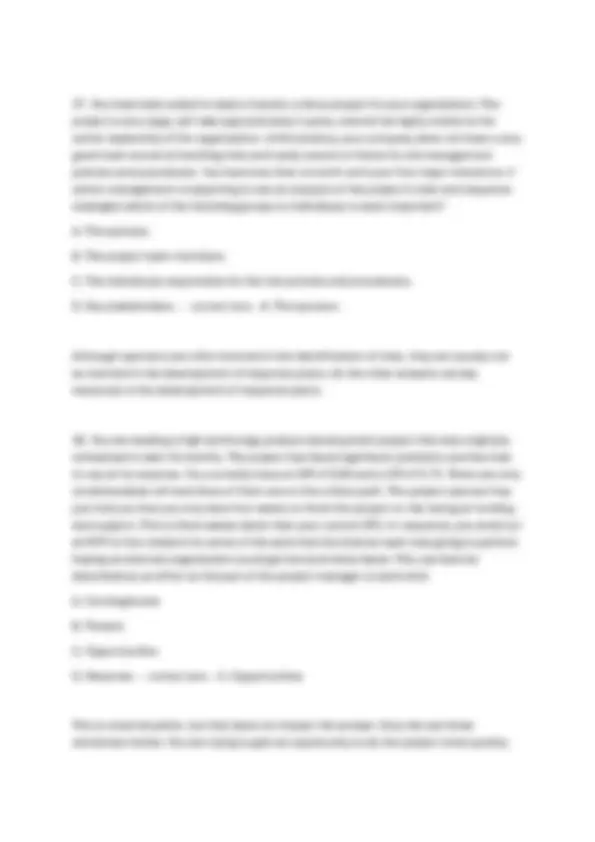





















Study with the several resources on Docsity

Earn points by helping other students or get them with a premium plan


Prepare for your exams
Study with the several resources on Docsity

Earn points to download
Earn points by helping other students or get them with a premium plan
Community
Ask the community for help and clear up your study doubts
Discover the best universities in your country according to Docsity users
Free resources
Download our free guides on studying techniques, anxiety management strategies, and thesis advice from Docsity tutors
2025 PMP Exam Chapter 11: Comprehensive Guide to Project Risk Management – Key Processes, Strategies, and Practice Questions for PMP Certification Success
Typology: Exams
1 / 27

This page cannot be seen from the preview
Don't miss anything!




















D. $51,600 - - correct ans- - A. $-38, To answer this question you must calculate the expected monetary value of each choice using the decision tree model found in your LGd training guide and then compare the options. Whichever option has the greatest value is the one you should choose. Decision Trees Prob P/L Net Out Total 56% 1,800K 1,150K 644K (650K) (38K) 44% (900K) (1,550K) (682K) 67% 950K 483K 323K (467K) (51K) 33% (670K) (1,137K) 375K 1 Which of the following is an input to the identify risks process? A. Project management plan B. SWOT analysis C. Risk related contracts D. Technical performance measurements - - correct ans- - A. Project management plan p. 396 - The inputs to the identify risks process includes: Project management plan Project documents Agreements Procurement documentation Enterprise environmental factors Organizational process assets
Meetings
Representations of uncertainty Data analysis
C. Status meetings D. Technical performance measurement - - correct ans- - A. Risk urgency assessment p. 396 - The tools and techniques used in the monitor risks process include:
Project management information system
This question is actually much easier than it first appears. Because we are assuming a range of estimates that is +/- 3 sigma, meaning it is a normal distribution, all you have to do is determine which range estimate has the smallest difference or variance. The 3 point estimate has a range of 13, the 33-46 days is a range of 13, and 40 +/- 8 days is 16.
B. Add them to the lessons learned for future projects. C. Read over the watch list as they are already covered in the properly completed contingency plans. D. Read over the watch list then revisit during monitoring and controlling. - - correct ans-
Finishing the risk response plan is done in the planning process group. The only of the options that is also in the planning process group is the completion of the work breakdown structure.
C. The scope statement from the project planning process. D. The resource plan from the project planning process. - - correct ans- - B. A discussion with several team members within the organization from a similar project that failed in the past. This question centers on imagining where you are in the project. The question gives you a charter and nothing else. Therefore, you must assume you are in the initiating process. Two of the other choices say they are from the planning process and therefore not available. The PMBOK® Guide is a nice framework, bur remember PMI® suggests the situation is critical.
C. Examine the RAM for necessary changes. D. Examine the budget for necessary changes. - - correct ans- - A. Update the risk register with any new risks and analysis. To answer this question correctly you had to notice the project is already significantly over budget and behind schedule. Changing the WBS, RAM, or budget should only happen in response to risks that occur. So you should start there.